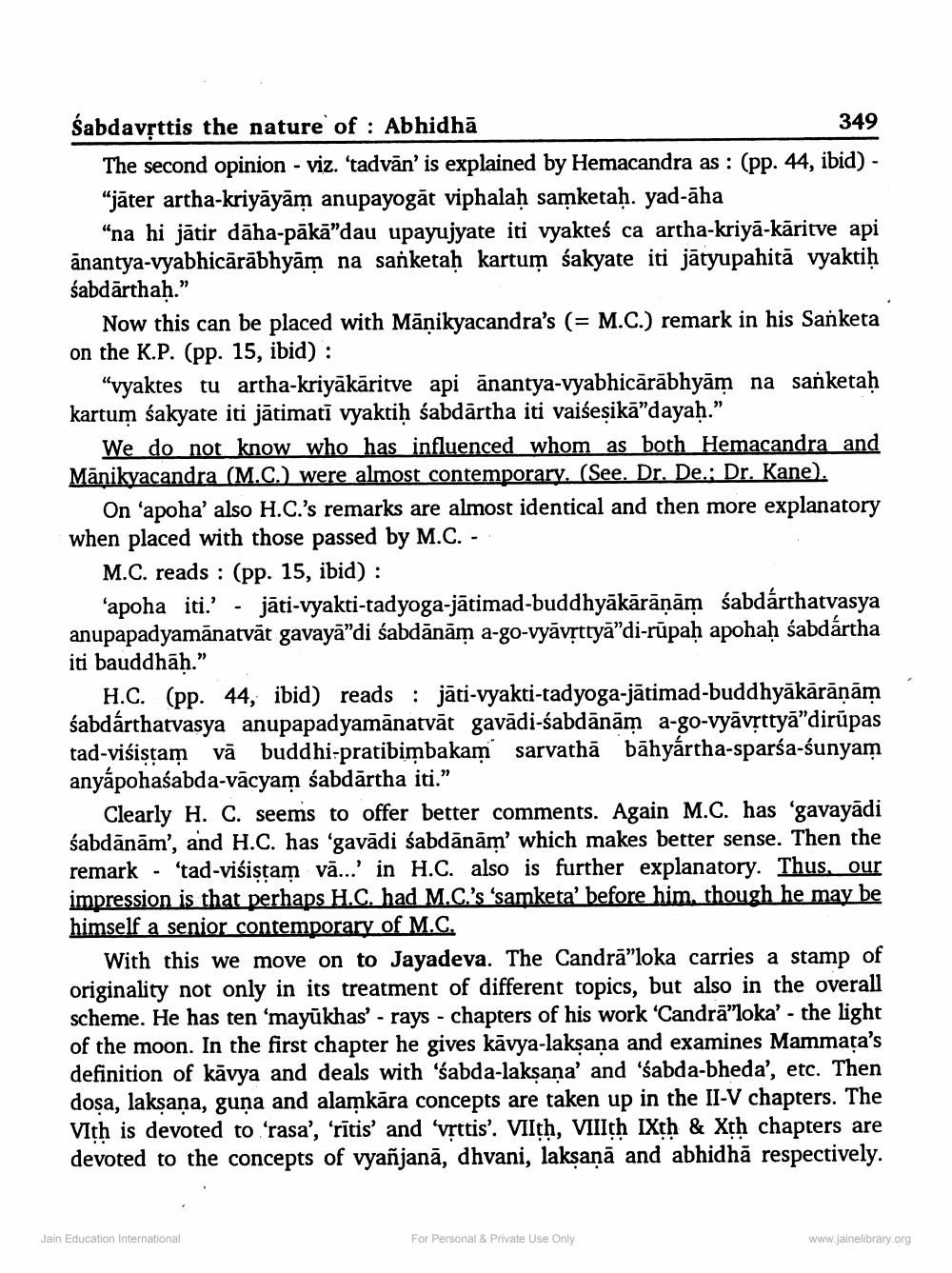________________
Śabdavșttis the nature of : Abhidhā
349 The second opinion - viz. 'tadvān' is explained by Hemacandra as : (pp. 44, ibid) - “jāter artha-kriyāyām anupayogāt viphalaḥ samketah. yad-āha
"na hi jātir dāha-pākā”dau upayujyate iti vyakteś ca artha-kriyā-kāritve api ānantya-vyabhicārābhyām na sanketaḥ kartum śakyate iti jātyupahitā vyaktiḥ śabdārthah."
Now this can be placed with Māņikyacandra's (= M.C.) remark in his Sanketa on the K.P. (pp. 15, ibid) :
"vyaktes tu artha-kriyākāritve api ānantya-vyabhicārābhyām na sanketah kartum śakyate iti jātimatī vyaktiḥ śabdārtha iti vaiśeșikā"dayah.”
We do not know who has influenced whom as both Hemacandra and Manikyacandra (M.C.) were almost contemporary. (See. Dr. De.: Dr. Kane).
On 'apoha' also H.C.'s remarks are almost identical and then more explanatory when placed with those passed by M.C. -
M.C. reads : (pp. 15, ibid):
‘apoha iti.' - jāti-vyakti-tadyoga-jātimad-buddhyākārāņām śabdárthatvasya anupapadyamānarvāt gavayā”di sabdānām a-go-vyāvịttyā”di-rūpaḥ apohaḥ śabdártha iti bauddhāh.”
H.C. (pp. 44, ibid) reads: jāti-vyakti-tadyoga-jātimad-buddhyākārāņām śabdárthatvasya anupapadyamānatvāt gavādi-sabdānām a-go-vyāvịttyā”dirūpas tad-visistam vā buddhi-pratibimbakam sarvathā bāhyártha-sparsa-bunyam anyápohaśabda-vācyam sabdārtha iti."
Clearly H. C. seems to offer better comments. Again M.C. has 'gavayādi sabdānām', and H.C. has 'gavādi sabdanăm' which makes better sense. Then the remark - 'tad-visistam vā...' in H.C. also is further explanatory. Thus, our impression is that perhaps H.C. had M.C.'s 'samketa' before him, though he may be himself a senior contemporary of M.C.
With this we move on to Jayadeva. The Candrā”loka carries a stamp of originality not only in its treatment of different topics, but also in the overall scheme. He has ten 'mayūkhas' - rays - chapters of his work 'Candrā”loka' - the light of the moon. In the first chapter he gives kāvya-laksana and examines Mammata's definition of kāvya and deals with 'sabda-laksana' and 'sabda-bheda', etc. Then dosa, laksana, guna and alamkāra concepts are taken up in the II-V chapters. The Vith is devoted to 'rasa', 'rītis' and 'vrttis'. VIIth, VIIIth IXth & Xth chapters are devoted to the concepts of vyañjanā, dhvani, laksana and abhidhā respectively.
Jain Education International
For Personal & Private Use Only
www.jainelibrary.org




